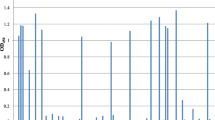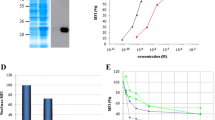Abstract
Two phage display antibody libraries (Tomlinson I and J) were screened against the whole oocysts of Cryptosporidium parvum to select for scFv (single chain variable fragment) antibodies. Three scFv antibodies were selected that bound to C. parvum oocysts as determined by monoclonal phage ELISA. DNA sequencing revealed that clone A11 lacked the majority of its V H chain. Clone B10 had a stop codon in the first framework region of the V H chain. We changed this stop codon to Gly by site-directed mutagenesis, and designated the variant mutB10. Clone B9 had a complete scFv gene with no internal stop codons. These antibody genes were individually subcloned into the pET-20b expression vector for soluble scFv antibody production. C. parvum infectivity was determined by infection of HCT-8 tissue culture monolayers and quantified by the foci detection method. By incubating C. parvum oocysts with individual scFv antibodies for 1 h at 37°C prior to infecting the HCT-8 cells with the oocyst-scFv mixture, the infectivity of C. parvum was reduced in a dose-dependant manner. At the highest soluble scFv concentration tested (4 nmol), the mean number of infectious foci was reduced by 82%, 73% and 94% for the A11, B9 and mutB10 scFv, respectively. This inhibition of oocyst infectivity was abolished when the scFvs were exposed to boiling water. The results showed that the 3 selected scFvs bound to C. parvum oocysts, and their ability to neutralize infectivity may have potential therapeutic potential against cryptosporidiosis.



Similar content being viewed by others
Abbreviations
- rAb:
-
Recombinant antibody
- scFv:
-
Single chain variable fragment antibody
- VH :
-
Variable region of the heavy chain
- VL :
-
Variable region of the light chain
References
Baecher-Allan CM, Santora K, Sarantopoulos S, Den W, Sompuram SR, Sharon J, Cevallos AM, Bhat N, Ward H (1999) Generation of a polyclonal Fab phage display library to the protozoan parasite Cryptosporidium parvum. Comb Chem High Throughput Screen 2:319–325
Barbas CF, Burton DR, Scott JK, Silverman GJ (2001) Phage display: a laboratory manual. Cold Spring Harbor Laboratory Press, Cold Spring Harbor, NY
Barik S (1996) Site-directed mutagenesis in vitro by megaprimer PCR. Methods Mol Biol 57:203–215
Carey CM, Lee H, Trevors JT (2004) Biology, persistence and detection of Cryptosporidium parvum and Cryptosporidium hominis oocyst. Water Res 38:818–862
Carreno RA, Pokorny NJ, Lee H, Trevors JT, DeGrandis SA (2001a) Phenotypic and genotypic characterization of Cryptosporidium species and isolates. J Ind Microbiol Biotechnol 26:95–106
Carreno RA, Pokorny NJ, Weir SC, Lee H, Trevors JT (2001b) Decrease in Cryptosporidium parvum oocyst infectivity in vitro by using the membrane filter dissolution method for recovering oocysts from water samples. Appl Environ Microbiol 67:3309–3313
Chen L, Williams BR, Yang CY, Cevallos AM, Bhat N, Ward H, Sharon J (2003) Polyclonal Fab phage display libraries with a high percentage of diverse clones to Cryptosporidium parvum glycoproteins. Int J Parasitol 33:281–291
Cevallos AM, Bhat N, Verdon R, Hamer DH, Stein B, Tzipori S, Pereira ME, Keusch GT, Ward HD (2000) Mediation of Cryptosporidium parvum infection in vitro by mucin-like glycoproteins defined by a neutralizing monoclonal antibody. Infect Immun 68:5167–5175
de Wildt RM, van Venrooij WJ, Winter G, Hoet RM, Tomlinson IM (1999) Somatic insertions and deletions shape the human antibody repertoire. J Mol Biol 294:701–710
de Wildt RM, Mundy CR, Gorick BD, Tomlinson IM (2000) Antibody arrays for high-throughput screening of antibody-antigen interactions. Nat Biotechnol 18:989–994
Doyle PS, Crabb J, Petersen C (1993) Anti-Cryptosporidium parvum antibodies inhibit infectivity in vitro and in vivo. Infect Immun 61:4079–4084
Elliot BC, Wisnewski AV, Johnson J, Fenwick-Smith D, Wiest P, Hamer D, Kresina T, Flanigan TP (1997) In vitro inhibition of Cryptosporidium parvum infection by human monoclonal antibodies. Infect Immun 65:3933–3935
Fayer R, Trout JM, Jenkins MC (1998) Infectivity of Cryptosporidium parvum oocysts stored in water at environmental temperatures. J Parasitol 84:165–169
Goletz S, Christensen PA, Kristensen P, Blohm D, Tomlinson I, Winter G, Karsten U (2002) Selection of large diversities of anti-idiotypic antibody fragments by phage display. J Mol Biol 315:1087–1097
Griffiths AD, Williams SC, Hartley O, 15 other authors (1994) Isolation of high affinity human antibodies directly from large synthetic repertoires. EMBO J 13:3245–3260
Kobayashi C, Yokoyama H, Nguyen SV, Kodama Y, Kimata T, Izeki M (2004) Effect of egg yolk antibody on experimental Cryptosporidium parvum infection in scid mice. Vaccine 23:232–235
Kristensen P, Winter G (1998) Proteolytic selection for protein folding using filamentous bacteriophages. Fold Des 3:321–328
Korich DG, Mead JR, Madore MS, Sinclair NA, Sterling CR (1990) Effects of ozone, chlorine dioxide, chlorine and monochloramine on Cryptosporidium parvum oocyst viability. Appl Environ Microbiol 56:1423–1428
Marks JD, Hoogenboom HR, Bonnert TP, McCafferty J, Griffths AD, Winter G (1991) By-passing immunisation. Human antibodies from V-gene libraries displayed on phage. J Mol Biol 222:581–597
Pokorny NJ, Weir SC, Carreno RA, Trevors JT, Lee H (2002) Influence of temperature on Cryptosporidium parvum oocyst infectivity in river water samples as detected by tissue culture assay. J Parasitol 88:641–643
Pokorny NJ, Boulter-Bitzer JI, Hall JC, Trevors JT, Lee H (2007) Recombinant antibodies for pathogen detection and immunotherapy. In: Gad SC (ed) Handbook of pharmaceutical biotechnology. John Wiley & Sons, Inc., Hoboken, NJ
Rochelle PA, Marshall MM, Mead JR, Johnson AM, Korich DG, Rosen JS, De Leon R (2002) Comparison of in vitro cell culture and a mouse assay for measuring infectivity of Cryptosporidium parvum. Appl Environ Microbiol 68:3809–3817
Sambrook J, Russell DW (2001). Molecular cloning: a laboratory manual, 3rd edn.
Slifko TR, Friedman D, Rose JB, Jakubowski W (1997) An in vitro method for detecting infectious Cryptosporidium oocysts with cell culture. Appl Environ Microbiol 63:3669–3675
Slifko TR, Huffman DE, Dussert BW, Owens JH, Jakubowski W, Haas CN, Rose JB (2002) Comparison of tissue culture and animal models for assessment of Cryptosporidium parvum infection. Exp Parasitol 101:97–106
Stibbs HH, Ongerth JE (1986) Immunofluorescence detection of Cryptosporidium oocysts in fecal smears. J Clin Micrbiol 24:517–521
Stewart CS, MacKenzie CR, Hall JC (2007) Isolation, characterization and pentamerization of a-cobrotoxin specific single-domain antibodies from a naive phage displaylibrary: Preliminary findings for antivenom development. Toxicon 49:699–709
Weir SC, Pokorny NJ, Carreno RA, Trevors JT, Lee H (2001) Improving the rate of infectivity of Cryptosporidium parvum oocysts in cell culture using centrifugation. J Parasitol 87:1502–1504
Weir C, Vesey G, Slade M, Ferrari B, Veal DA, Williams K (2000) An immunoglobulin G1 monoclonal antibody highly specific to the wall of Cryptosporidium oocysts. Clin Diagn Lab Immunol 7:745–750
Yau KYF, Lee H, Hall JC (2003) Emerging trends in the synthesis and improvement of hapten-specific recombinant antibodies. Biotech Adv 21:599–637
Acknowledgements
Our research on Cryptosporidium was supported by the Canadian Water Network (CWN) Center of Excellence, Natural Sciences and Engineering Research Council (NSERC) of Canada, and Ontario Ministry of Agriculture and Food. We thank the NIH AIDS Research and Reference Reagent Program, Division of AIDS, NSAID, NIH for oocysts of C. parvum MD strain, provided by Dr. Saul Tzipori. We would also like to thank Sara Mohr of the University of Guelph for supplying the anti-cholera toxin subunit B scFv. The Tomlinson libraries were provided by the Medical Research Council Laboratory of Molecular Biology (now Geneservive Ltd.) (Cambridge, UK).
Author information
Authors and Affiliations
Corresponding authors
Rights and permissions
About this article
Cite this article
Pokorny, N.J., Boulter-Bitzer, J.I., Hall, J.C. et al. Inhibition of Cryptosporidium parvum infection of a mammalian cell culture by recombinant scFv antibodies. Antonie van Leeuwenhoek 94, 353–364 (2008). https://doi.org/10.1007/s10482-008-9252-0
Received:
Accepted:
Published:
Issue Date:
DOI: https://doi.org/10.1007/s10482-008-9252-0




